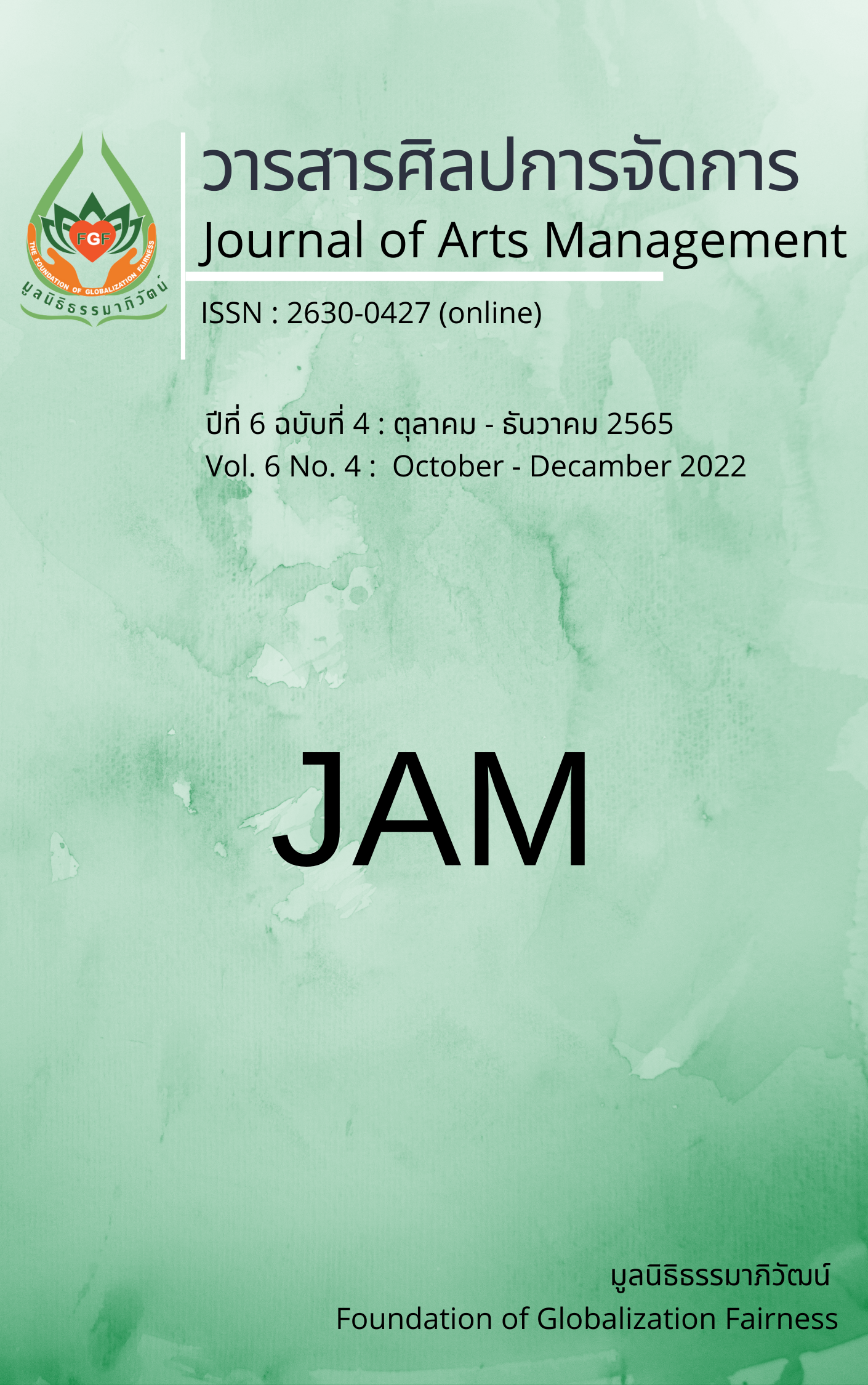A Model of Empowering Leadership to Affect Organizational Citizenship Behavior in Basic Education Institutions
Main Article Content
Abstract
The objectives of this paper were: 1) to study the causal model of empowered leadership that affects organizational membership behavior of teachers in primary schools; and 2) to examine the coherence of the causal model of empowered leadership affecting organizational membership behavior of teachers in basic education schools with empirical data. The research model was quantitative research. The sample group consisted of 400 administrators and teachers in educational institutes under the Phetchaburi Secondary Education Service Area Office, which consisted of using Multi-Stage Random Sampling. using basic statistics and analysis of the Structural Equation Model (SEM).
The results were found: 1) The results of the analysis and harmonization of the theoretical model of the causal relationship structure model of empowered leadership affecting organizational membership behavior of teachers in basic education institutions were consistent. with empirical data The statistical harmonization of the Empowered Leadership Model that affects the organizational membership behavior of teachers in basic education institutions is as follows: x2 = 272.11, P-Value = 0.668, df = 283, GFI = 0.96, AGFI = 0.93, CFI = 1.00, SRMR = 0.04, RMSEA = 0.001, 2) The latent variables of empowerment leadership that indirectly influenced through various factor variables to the good organizational membership behavior of teachers in basic education institutions. can be described as 94 percent.
Article Details

This work is licensed under a Creative Commons Attribution-NonCommercial-NoDerivatives 4.0 International License.
Views and opinions appearing in articles in the Journal of Arts of Management It is the responsibility of the author of the article. and does not constitute the view and responsibility of the editorial team I agree that the article is copyright of the Arts and Management Journal.
References
Amundsen, S., & Martinsen, O.L. (2014). Empowering leadership: Construct clarification, conceptualization, and validation of a new scale. The Leadership Quarterly, 25(3), 487-511.
Arnold, J. A., Arad, S., Rhoades, J. A., & Drasgow, F. (2000). The Empowering Leadership Questionnaire: the construction and validation of a new scale for measuring leader behaviors. Journal of Organizational Behavior, 21(3), 249-269.
Avey, J. B., Luthans, F., & Jensen, S. M. (2009). Psychological capital: A positive resource for combating employee stress and turnover. Human Resource Management, 48(5), 677–693.
Bandura, A. (1989). Social Foundation of thought and action: A social cognitive theory. Prentice-Hell.
Bandura, A. (1996). Social cognitive theory of human development. Pergamon Press.
Becker, H. S. (1960). Notes on the concept of commitment. American Journal of Sociology, 66, 32–40. https://doi.org/10.1086/222820
Nakro, C., & Iamsupasit, S. (2020). The Relationship Between Perceived Organizational Justice, Relations with Supervisors and Organizational Citizenship Behavior of Employees in Private Company by Organziational Commitment as a Moderator. Journal of Humanities and Social Sciences Valaya Alongkorn, 15(2), 83-98. https://so06.tci-thaijo.org/index.php/vrurdihsjournal/article/view/243676/166901
Chuensanguan, P. (2011). The relationship between spiritual intelligence. a sense of self-worth and The joy of working for a flight attendant Thai Airways Company Limited{Master's Thesis, Thammasat University, Bangkok].
Chusai, P. (2004). The relationship between corporate engagement and good organizational membership behavior of bank of Thailand employees[Master’s Thesis, Kasetsart University].
Coopersmit, S. (1984). SE I: Self-Esteem Inventories (2nd ed.). Consulting Psychologists.
Gibson, G. H. (1991). A concept analysis of empowerment. Journal of Advanced Nursing, 16(3), 354-361.
Hokanson, H. (1992). Empowerment in nursing education: concept analysis and application to philosophy, learning and instruction. Journal of Advanced Nursing, 17(5), 609-618.
Katzenbach, J. R., & Smith, D. K. (1993). The Wisdom of Teams. Harper Collins.
Kim, M., & Beehr, T. A. (2017). Self-efficacy and psychological ownership mediate the effects of empowering leadership on both good and bad employee behaviors. Journal of Leadership & Organizational Studies, 24(4), 466-478.
Kim, M., & Beehr, T. A. (2018). Organization-Based Self-Esteem and Meaningful Work Mediate Effects of Empowering Leadership on Employee Behaviors and Well-Being. Journal of Leadership & Organizational Studies, 25(4).
Leithwood, K., & Jantzi, D. (2006). Transformational school leadership for large-scale reform: Effects on students, teachers, and their classroom practices. School Effectiveness and School Improvement, 17(2), 20-227.
Maslow, A. H. (1970). Motivation and Personality. Harper and Row.
Morin, E. (2008). On Complexity. Hampton.
Sanguanyayat, O. (2001). A study of the structural validity of self-esteem tests with different response and analysis patterns[Master’s Thesis, Srinakharinwirot University].
Organ, D. W. (1991). The applied psychology of work behaviors. Richard D. Irwin.
Patamawan, C. (2004). Relationship between corporate commitment and behavior A good member of the organization of employees of the Bank of Thailand[Master’s Thesis, Kasetsart University].
Peters, J., & Carr, C. (2013). Team effectiveness and team coaching literature review. Coaching: An International Journal of Theory, Research and Practice, 6(2), 116–136. https://doi.org/10.1080/17521882.2013.798669
Pierce, J. L., Kostova, T., & Dirks, K. T. (2001). Toward a Theory of Psychological Ownership in Organizations. Academy of Management Review, 26, 298-310.
Porter, M. E. (1990). The Competitive Advantage of Nations. Macmillan.
Serirat, S. (2007). Consumer Behavior. Theera Film & Scitex.
Spreitzer, G. M. (1995). Psychological empowerment in the workplace: Dimensions, measurement, and validation. Academy of Management Journal, 38(5), 1442-1465.
Srinual, W., & Supparerkchaisaku, N. (2016). Structural Relationship Model of Causal Factors of Psychological Ownership on Organizational Effectiveness Variables of Manufacturing Organization Employees. Journal of Behavioral Science, 22(2), 65-84.
Tebbit, C. (1993). Demystifying organization empowerment. Journal of Nursing Administration, 23(1), 18-23.
Thainews. (2021). Fired, 2 teachers quarreled and beaten holding a knife intimidating a female teacher in front of students the school prepares a statement of facts. https://www.tnews.co.th/social/542385?fbclid=IwAR1VUl2yjmnAxgLsFBnKMVOF4lExJVCm 8dJDhVVOlcp0Na_be_VyVvCCOpU
Thongpull, K., Rugchoochip, R., & Na-Nan, K. (2016). A Causal Model of Job Characteristics, Transformational Leadership, and Perceived Organizational Support Effects on Organizational Commitment and Organizational Citizenship Behavior. Suthiparita Journal, 30(93), 131-145.
Viriyamano, K., Ounok, N., & Limoubpratum, C. (2020). Teamwork that affects good organizational membership behavior of hospital personnel. Sripatum Academic Journal, Chonburi, 17(1). 159-168
Woodcock, M., & Francis, D. (1994). Teambuilding Strategy (2nd ed.). Cambridge University.


